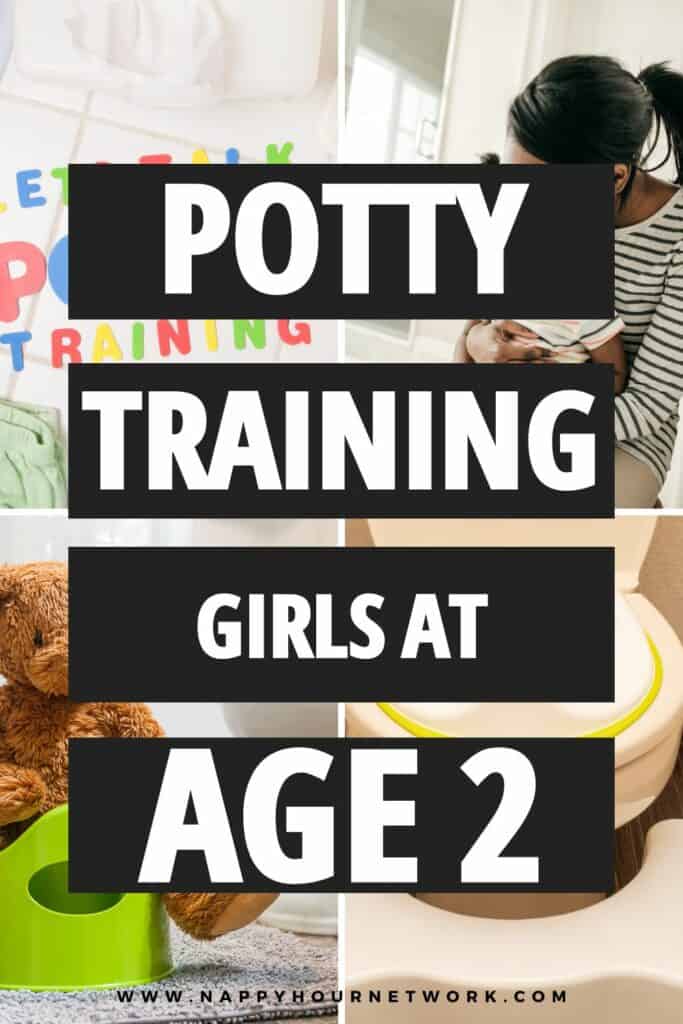Potty Training Girls At Age Two
Potty training girls is a significant milestone for both parents and children, and the key to success lies in the virtues of patience. Rather than succumbing to external pressure or predefined age expectations, it’s crucial to recognize that each child has their own pace of development. The process of potty training is not a race against time; rather, it’s a journey guided by your child’s individual readiness. Understanding and embracing this reality can make the entire experience smoother and more successful.
In this post, I suggest some potty training girls tips that will help you when it is time to start this process.

Signs of Readiness: Child’s Cues
Determining your child’s readiness for potty training is not solely about age but involves recognizing specific signs. Look for cues such as your child’s interest in using the potty, verbalizing their needs, and staying dry for an extended period. If your child can communicate when they need to go, follow simple instructions, and express an interest in independence, they might be ready. Keeping an eye out for these signals allows you to embark on the potty training journey when your child is genuinely prepared, minimizing potential challenges and frustrations.
Choosing the Right Time: Rejecting Age-Related Myths
The right time to begin potty training is a subjective decision based on your child’s unique development. Avoid falling into the trap of age-related myths or external pressures to start too early. Starting the process too soon may lead to unnecessary delays and difficulties. Trust your instincts as a parent and let your child’s cues guide the journey. Waiting until your child is genuinely ready, even if it’s beyond the conventional timeline, sets the stage for a more positive and successful potty training experience.
Parental Readiness: Supporting Your Child’s Journey
While recognizing your child’s readiness is crucial, being prepared as a parent is equally important. Patience and understanding play a pivotal role in the potty training process. Instead of rushing the process based on eagerness or external expectations, let your child’s motivation lead. Understand that success or difficulty in potty training isn’t a reflection of intelligence or stubbornness. Maintaining a positive and supportive approach contributes significantly to creating an environment where your child can confidently embrace this developmental stage.
Practical Tips for Parents: Setting the Stage for Success
Preparing for potty training involves practical steps that set the stage for success. Start by creating a checklist based on your child’s readiness signals. Choose appropriate words and phrases, avoiding negativity. Introduce a potty chair early on, letting your child become familiar with its purpose. Encourage curiosity by involving them in the selection process. Establishing a routine for potty breaks and making the experience positive through praise and reinforcement are key elements in creating a supportive atmosphere for your child’s potty training journey.
Potty Training Readiness Checklist: A Handy Guide for Parents
As you navigate the potty training journey, a readiness checklist can be a valuable tool. Assess your child’s interest, ability to communicate, and understanding of basic instructions. If your child can stay dry for at least two hours, express the need to use the potty, and show interest in independence, they might be ready. Use this checklist as a personalized guide, aligning it with your child’s unique cues and development. This proactive approach ensures that you initiate potty training at the right time, setting the foundation for a successful transition.
Common Myths about Potty Training: Separating Fact from Fiction
Dispelling common myths about potty training is essential for informed decision-making. Challenge misconceptions about age-related readiness and understand that there’s no universal “right age” for potty training. Recognize that every child is different, and focusing on individual signs of readiness is more effective than adhering to predetermined age norms. By separating fact from fiction, parents can approach potty training with a clearer perspective, fostering a positive and supportive environment for their child’s developmental journey.
The Role of Language in Potty Training: Positive Communication Matters
Language plays a crucial role in potty training success. Choose positive and encouraging words when discussing bodily functions with your child. Avoid using negative terms and create a vocabulary that makes the process less intimidating. By associating positivity with the potty, you contribute to a more relaxed and enjoyable experience for your child. The right words can foster a sense of understanding and cooperation, making potty training a collaborative effort between parent and child.
Introducing the Potty: Making It Familiar for Your Child
Introducing the concept of the potty to your child is a gradual process that can ease them into the idea. Place a potty chair in a familiar location and explain its purpose in simple terms. Let your child participate in choosing the potty chair to build excitement. Encourage them to sit on the potty fully clothed initially, gradually progressing to diaper-free sessions. Demonstrating the purpose of the potty by disposing of a dirty diaper and flushing it down the toilet can demystify the process for your child.
Preparing for Potty Training: Steps for Success
Even before signs of readiness become evident, there are steps parents can take to prepare their child for potty training. Acquaint your child with the concept of the potty by using age-appropriate language such as “pee pee” and “poop.” Show them where the poop from their diaper goes, gradually introducing them to the idea. If possible, allow your child to witness family members using the toilet. These preparatory steps create familiarity with the potty, making the eventual transition into potty training smoother and less intimidating.
Starting Potty Training: Focus on Success and Positive Reinforcement
Once you’ve identified the signs of readiness and prepared your child for the journey, it’s time to start potty training. Begin with a focus on bowel training, allowing your child to get comfortable with the potty. Let them sit on the potty fully clothed and progress to diaper-free sessions when they are ready. Change your child’s diaper while they’re on the potty to reinforce the connection between the two. Introduce the habit of handwashing after each potty session, emphasizing positive reinforcement and making the experience enjoyable.
Nighttime Training: Navigating Challenges Successfully
Nighttime training is a unique aspect of the potty training process, often requiring additional time and patience. While most children can stay dry at night between ages 5 and 7, it’s essential to be patient during this phase. Use disposable training pants and mattress covers to manage nighttime accidents. Maintain a positive and encouraging atmosphere, understanding that nighttime training may take longer to achieve. By navigating nighttime challenges with patience and support, you contribute to your child’s overall potty training success.
Dealing with Accidents: Stay Calm and Positive
Accidents are an inevitable part of the potty training journey. When they occur, it’s crucial to stay calm and positive. Avoid scolding or shaming your child; instead, reassure them that accidents happen, and they can try again next time. By maintaining a supportive attitude, you create a safe environment for your child to learn from their experiences. Keep a change of underwear and clothing handy, especially when you’re outside of the home, to manage accidents effectively.
Knowing When to Delay Potty Training: Trusting Your Instincts
Trusting your instincts as a parent is paramount when deciding whether to delay potty training. Even if your child displays signs of readiness, certain situations may warrant a delay. For instance, if your child is unwell, going through a major transition like moving to a new home, or welcoming a new sibling, it might be wise to postpone potty training. Timing is crucial, and understanding when external factors may impact your child’s receptiveness to training is a thoughtful approach. Trusting your instincts and recognizing the right moments for your child can contribute to a more successful and less stressful potty training experience.
Celebrating the Potty Training Journey
In conclusion, potty training is a developmental milestone that requires patience, understanding, and a personalized approach. Recognizing the signs of readiness, debunking common myths, and maintaining a positive atmosphere are key elements of a successful potty training journey. By choosing the right time, preparing both your child and yourself, and navigating challenges with a supportive mindset, you can celebrate each step of progress. Remember, potty training is a unique experience for every family, and with the right guidance, it can become a positive and empowering chapter in your child’s early years. Embrace the journey, celebrate successes, and foster a supportive environment that sets the stage for confident and independent toddlers. Happy potty training!









